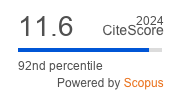SKIN LESION SEGMENTATION BY PIXEL BY PIXEL APPROACH USING DEEP LEARNING
DOI:
https://doi.org/10.29284/ijasis.6.1.2020.12-20Keywords:
Image segmentation, skin lesion segmentation, top-hat transform, pixel classification, deep learning.Abstract
Skin lesion segmentation is an imperative step for image analysis and visualization task. Manual segmentation by an expert operator is too time-consuming and its accuracy may be degraded by different human operators. An automatic segmentation method is therefore required and one of the important parts in any classification system. In this work, more accurate skin lesion segmentation by Pixel-by-Pixel (PbP) approach using deep learning is presented. Before employing PbP approach, dermoscopic images are prepared for more accurate segmentation by Top-Hat Transform (THT) which removes the hair in the skin regions. The PbP approach has four stages; study the training images consists of skin lesions, construction of deep learning network followed by training it and finally evaluate the network with testing images. The evaluation of PbP approach is carried out using PH2 database images. Results of PbP approach in terms of Jaccard Index (JI), Accuracy (Acc) and DIce Coefficients (DIC) show the effectiveness of the system for skin lesion segmentation.
References
M.A. Khan, M.I. Sharif, M. Raza, A. Anjum, T. Saba and S.A Shad, “Skin lesion segmentation and classification: A unified framework of deep neural network features fusion and selection”, Expert Systems, Vol. 83, No. 5, 2019, pp. 562-576.
J. Lameski, A. Jovanov, E. Zdravevski, P. Lameski and S. Gievska, “Skin lesion segmentation with deep learning”, International Conference on Smart Technologies, 2019, pp. 1-5.
M. Goyal, A. Oakley, P. Bansal, D. Dancey and M. H. Yap, “Skin Lesion Segmentation in Dermoscopic Images With Ensemble Deep Learning Methods”, IEEE Access, Vol. 8, 2019, pp. 4171-4181.
A. Pennisi, D.D. Bloisi, D. Nardi, A.R. Giampetruzzi, C. Mondino and A. Facchiano, “Skin lesion image segmentation using Delaunay Triangulation for melanoma detection”, Computerized Medical Imaging and Graphics, Vol. 52, 2016, pp. 89-103.
K. Swathi and C.K. Raghavendra, “Melanoma Detection and Classification System using Artificial Neural Networks”, International Journal of Trend in Research and Development, Vol.4, No.3, 2017, pp. 384-388.
H. Wang, R.H. Moss, X. Chen, R.J. Stanley, W.V. Stoecker, M.E. Celebi and S.W. Menzies, “Modified watershed technique and post-processing for segmentation of skin lesions in dermoscopy images”, Computerized Medical Imaging and Graphics, Vol. 35, No. 2, 2011, pp. 116-120.
O. Abuzaghleh, B.D. Barkana, and M. Faezipour, “Automated skin lesion analysis based on color and shape geometry feature set for melanoma early detection and prevention”, Conference on Systems, Applications and Technology, 2014, pp. 1-6.
K. Lawand, “Segmentation of Dermoscopic Images”, IOSR Journal of Engineering, Vol. 4, No. 4, 2014, pp. 16-20.
R. Garnavi, M. Aldeen, M.E. Celebi, A. Bhuiyan, C. Dolianitis, and G.Varigos, “Automatic segmentation of dermoscopy images using histogram thresholding on optimal color channels”, International Journal of Medicine and Medical Sciences, Vol. 1, No. 2, 2010, pp. 126-134.
A. Selvaraj, “Segmentation and Classification of Skin Lesions Based on Texture Features”, International Journal of Engineering Research and Applications, Vol. 4, No. 12, 2014, pp. 197-203.
T. Mendonca, A.R. Marcal, A. Vieira, J.C. Nascimento, M. Silveira, J.S. Marques and J. Rozeira, “Comparison of segmentation methods for automatic diagnosis of dermoscopy images”, IEEE conference In Engineering in Medicine and Biology Society, 2007, pp. 6572-6575.
O. Abuzaghleh, B.D. Barkana and M. Faezipour, “Automated skin lesion analysis based on color and shape geometry feature set for melanoma early detection and prevention”, IEEE conference on Systems, Applications and Technology, 2014, pp. 1-6.
H. Sood and M. Shukla, “Segmentation of skin lesions from digital images using an optimized approach: Genetic algorithm”, International Journal of Computer Science and Information Technologies, Vol. 5, No. 5, 2014, pp. 6831-6837.
A.A.A. Al-abayechia, X. Guoa, W.H. Tana and H.A. Jalabc, “Automatic skin lesion segmentation with optimal colour channel from dermoscopic images”, Science Asia, Vol. 40, No. 1, 2014, pp. 1-7.
V. Revathi and A. Chithra, “A review on segmentation techniques in skin lesion images”, International Research Journal of Engineering and Technology, Vol. 2, No. 9, 2015, pp. 2598-2603.
N. Situ, X. Yuan, G. Zouridakis and N. Mullani, “Automatic segmentation of skin lesion images using evolutionary strategy”, IEEE International Conference on Image Processing, Vol. 6, 2007, pp. VI-277.
M. Ruela, C. Barata, T. Mendonca and J.S. Marques, “On the role of shape in the detection of melanomas”, International Symposium on Image and Signal Processing and Analysis, 2013, pp. 268-273.
J. Serra, “Image analysis and mathematical morphology”, Academic Press, Inc., 1983.
L.C. Chen, Y. Zhu, G. Papandreou, F. Schroff and H. Adam, “Encoder-decoder with atrous separable convolution for semantic image segmentation”, Proceedings of the European conference on computer vision, 2018, pp. 801-818.
T. Mendonça, P.M Ferreira, J.S. Marques, A.R. Marcal and J. Rozeira, “PH2-A dermoscopic image database for research and benchmarking”, 35th annual international conference of the IEEE engineering in medicine and biology society, 2013, pp. 5437-5440.
PH2 Database Link: https://www.fc.up.pt/addi/ph2%20database.html
Downloads
Published
Issue
Section
License
This work is licensed under a Creative Commons Attribution 4.0 International License, which permits unrestricted use, distribution, and reproduction in any medium, provided the original work is properly cited.











